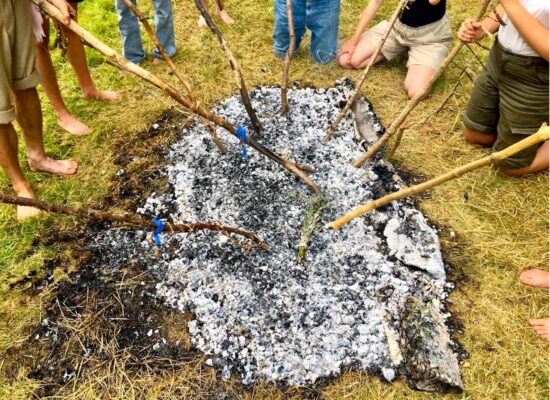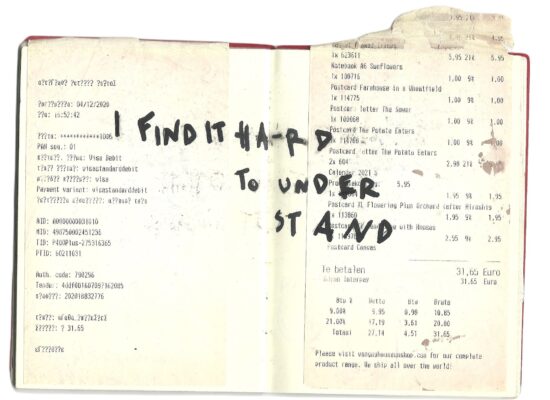Based in Antwerp, Belgium and Milan, Italy
Website https://www.mahmoudsalehmohammadi.com
Research project The significance, importance and possibilities of participatory art in a multi-cultural and multi-social urban environment
Location Royal Academy of Fine Arts Antwerp
Can you describe your research project?
I’m excited to share my research project, “The significance, importance, and possibilities of participatory art in a multicultural and multi-social urban environment.” My overall artistic practice combines visual art and community engagement, with Spazio Nour at its heart. Through various socially engaged art projects across Europe, I invite residents from specific social contexts to co-create, where art becomes a means for them to express their unique narratives and cultural identities. I focus on tailoring each project to local needs, often without framing it as contemporary art—because for many in the communities I work with, that’s a big leap. It’s about creating art by and for the people, with an emphasis on long-term impact.
Spazio Nour started in a notorious building marked by crime and violence. As a young artist, it was where I rented my studio and organized artistic activities. Witnessing the positive impact on residents sparked my curiosity about the why and how of this transformation, which became the foundation of my research. This experience became the foundation of my research into participatory art, specifically investigating how community engagement through art can foster social change and build a sense of belonging. My research question centers on understanding the dynamics of these interactions: how can participatory art serve as a catalyst for community resilience and mental health in marginalized urban or rural environments? I thus aim to understand which role art can play in creating safespaces and promoting dialogue in diverse social contexts.
Through my research, I’ve discovered that participatory art isn’t merely about aesthetics; it’s about creating essential platforms for community engagement and empowerment. I stress the importance of cultural sensitivity and adaptability, as art can connect us meaningfully in diverse urban landscapes (Bishop, 2006; Kester, 2004).
A standout project has been the First Supper, which began in Milan and later extended to Fossa and Antwerp. Inspired by the Last Supper of Jesus Christ, it brings people together for communal meals, highlighting the power of bonding and sharing over food. In Milan, we hosted it annually at the end of Ramadan, where everyone brought their own plate. This ritual created anticipation and fostered a sense of community.
My work across various European neighborhoods has shown me how co-creation and collaboration can break down barriers for marginalized communities, giving them a voice to share their experiences. This process fosters ownership, transforming participants from passive observers into active contributors (Finkelpearl, 2013). Ultimately, my findings affirm that participatory art can be a powerful vehicle for social change, inspiring unity and fostering empathy in our increasingly complex urban environments.

Why have you chosen this topic?
I chose this topic because it lies very close to my heart, my socially engaged practice began when I moved to Italy as an art student in 2011. Art became my way of connecting with the new society in Milan, using paintings, installations, and performances. I started creating workshops and social projects in the building where I was living to establish a safe space for myself and integrate into the community. Over time, this not only helped me find a sense of belonging, but also had a significant impact on the people around me.
This experience led me to explore participatory and socially engaged art through contemporary art language. I gradually developed different projects focused on community building and fostering a sense of belonging, using empathy to promote mental health and trust between myself and the community. As the projects gained momentum, I collaborated with various organizations in Milan, contributing to successful initiatives like the Milan Expo 2015 and partnering with institutions such as Politecnico di Milano, Enel Green Power, and UN Geneva. I was also invited to join the Empathy Foundation in Milan as one of its first members.
After completing my Master’s in Visual Arts at Accademia di Brera in 2017, I aimed to deepen my theoretical research on participatory and socially engaged art, having previously collaborated with NABA on social design courses. I met Professor Ria de Boodt at the Royal Academy in 2019 or 2020, which opened doors for me to join the research group “Body and Material Reinvented.” It felt like the perfect fit for my interests.
Moving to Antwerp, I moved to Merksemdok where I started collaborating with the cultural center for community building in socially engaged art for my Royal Academy project. I immersed myself in the neighborhood where industry boarders to the residency for over a year, to understand the social fabric and initiate collaborations with local organizations and people. This groundwork informed my participatory art projects tailored for the community.
After completing my research in September 2023, I am working on a publication that will be released next month. I decided to stay in Antwerp to continue my visual art practice while further exploring the theoretical aspects of participatory art. I found a space in Wechelderzande, near Lille, where I hope to be able to establish a house for participatory art, bringing together my art practice and research in one place, opening it to the public as well.

What research methods do you use?
In my research, I employ a combination of qualitative methods that focus on community engagement and participatory practices. I prioritize ethnographic observation to gain a deep understanding of the social dynamics within specific neighborhoods. This involves immersing myself in the community, observing interactions, and documenting experiences over an extended period.
I also conduct interviews and focus groups with community members, which allow me to gather diverse perspectives and narratives. These conversations often reveal underlying issues and aspirations that can shape the direction of participatory art projects.
Additionally, I emphasize collaborative research by working alongside local organizations and residents. This approach fosters trust and ensures that the projects are relevant and responsive to the community’s needs. Through co-creation, I aim to transform participants from passive observers into active contributors, allowing their voices to shape the artistic process.
Finally, I incorporate reflective practice throughout my research journey. By documenting my experiences and the outcomes of various projects, I continuously refine my methodologies and deepen my understanding of participatory art’s impact in multicultural urban environments.

In what way did your research affect your artistic practice?
My research has had a personal impact on me, reshaping how I think about art in relation to society. I began to see art not just confined to the “white cube,” but as a shared experience—art created by and for the people. It’s become clear to me that art can serve as a powerful catalyst for balance and mental well-being within communities.
This shift has reinforced my belief that art is one of the best ways to educate and connect with people. I’ve seen first-hand how participatory practices can foster a sense of belonging, allowing individuals to share their stories and experiences in a meaningful way. Ultimately, my research has transformed my artistic practice into one that values collaboration and inclusivity, highlighting art’s potential to inspire social change and enrich lives.

What are you hoping your research will result in, both personally and publicly?
I hope my research can allow me to share this art language with others who are interested. My goal is to bring this practice to different social realities where it can make a real difference. For me, this research is like an open book—I learn something new every day from the people I engage with, and each of these insights adds value to my artistic practice and the other way around.
Personally, I aspire to keep growing alongside this project, using it as a platform to deepen my understanding of community engagement through art. Publicly, I envision collaborative projects that inspire others to embrace participatory art as a means of fostering connection and dialogue. Ultimately, I want this research to be a source of inspiration for those seeking to create impact through art, helping them find their own voice and sense of belonging.

The publication Art for the People, Art by the People by Mahmoud Saleh Mohammadi is available here.




